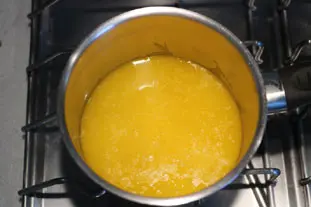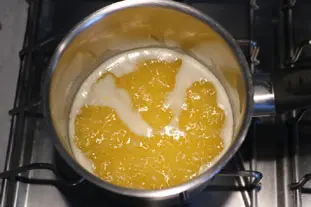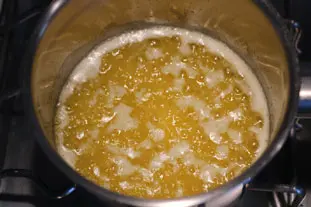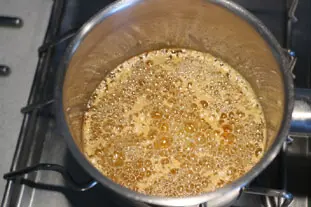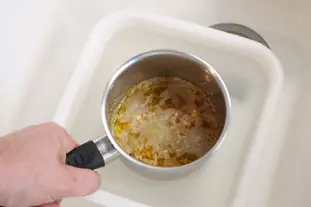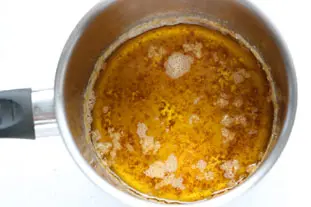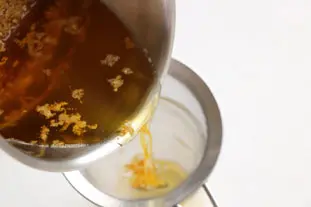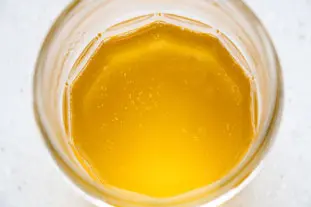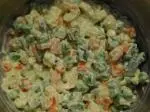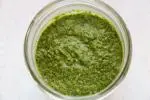This site uses only a few technical cookies necessary for its operation. By continuing to browse, you accept their use.
To find out more...
To find out more...
Noisette butter
"Noisette" means hazelnut in French. Noisette butter is made by melting butter, then boiling and raising it to a high temperature until it takes on both a light brown hazelnut colour and also a characteristic nutty smell.
Compared with simple clarified butter, this noisette butter has a delicate yet distinctive flavour which is a welcome addition to both savoury and sweet recipes (particularly in cakes and pastries).
Compared with simple clarified butter, this noisette butter has a delicate yet distinctive flavour which is a welcome addition to both savoury and sweet recipes (particularly in cakes and pastries).
143 K 4.0/5 (23 reviews)
Last modified on: August 27th 2025
For 100 g, you will need:
- 1
 125 g butter
125 g butter - Total weight: 125 grams
Times for this recipe
Cooking: 15 min.
Step by step recipe
Cut 125 g butter into pieces, put into a saucepan on medium heat and melt.
Note: Cutting the butter into pieces for this stage, rather than starting with a large block, allows it to melt and raise its temperature more evenly.
Note: Cutting the butter into pieces for this stage, rather than starting with a large block, allows it to melt and raise its temperature more evenly.
At the end of the cooking process, the butter will have stopped bubbling, or almost, and will now be a light brown colour and give off a hazelnut smell.
Take the pan off the heat and stand it immediately in cold water for 30 seconds to stop the cooking.
Note: It is very important to cool the butter like this, or it will continue to heat up, even off the hob, and will end up burning and turning black.
Note: It is very important to cool the butter like this, or it will continue to heat up, even off the hob, and will end up burning and turning black.
The hazelnut butter thus obtained, and this is normal, contains small impurities, the buttermilk, which has cooked with it and is best removed.
Filter the noisette butter through a fine strainer.
Remarks
You can avoid cooling the pan in stage 7 by filtering the noisette butter immediately into another (cold) container.
You can also use slightly salted butter, but do be aware that the cooking to noisette stage will concentrate the initial saltiness.
You will have noticed how hot the butter gets towards the end of cooking — a bit like making caramel — so I advise you not to make it when there are young children in the kitchen.
You can also use slightly salted butter, but do be aware that the cooking to noisette stage will concentrate the initial saltiness.
You will have noticed how hot the butter gets towards the end of cooking — a bit like making caramel — so I advise you not to make it when there are young children in the kitchen.
Keeping: Several days in the fridge, in a sealed container.
Source: Home made.
How much will it cost?
- For 100 g : 0.90 €
Change currency:
Note: Be careful, these prices are only an estimate, you can consult the table of prices by ingredients used for this estimate.
Some other recipes using this recipeSee them all 10
Pistachio "Financiers"
This version of the traditional French financiers is just as moist as the original but with a delicious pistachio flavour.
90 K3.9 35 min.
Clafoutis batter
Clafoutis is a cake from the Limousin region of France, made with a liquid batter similar to pancake batter, into which fruit is added before baking. Here's a recipe for clafoutis batter, which you can use with any fruit you like.
37 K5 6 min.
Chestnut cake
This delightful cake is doubly chestnutty: it contains chestnut flour, and sweet chestnut purée.
354 K5 1 hour 15 min.
Pancake batter
Here is a pancake batter that is a little more sophisticated than the traditional version. The pancakes will be tastier with a softer texture.
388 K3.8 15 min.
This recipe uses (among others)

Butter
Like these other recipes: Tart Tatin, Passion fruit jellies, Mushrooms in snails, Roasted cauliflower, Kouign-amann brioche, ... See them all 484
Other recipes you may also like
Macédoine of vegetables
A macédoine is simply vegetables diced small (carrots and turnips) or cut small (green beans) with peas. The different vegetables are cooked separately "à l'anglaise", then thoroughly drained. They are only combined at... September 3rd 2014183 K4 1 hour 25 min.
Purée of Jerusalem artichokes with foie gras
This recipe features a rather unexpected combination that works really well: the distinctive flavour of Jerusalem artichoke with the richness of foie gras. The Jerusalem artichokes are puréed with potatoes. This is serves hot mixed with very cold diced foie gras. The combination of flavours and contrast of hot and cold is delicious. January 11th 202379 K4.1 20 min.
Chestnut moelleux
"Moelleux" means soft, and is also the name given to the gooey, soft-centred cakes that are popular in France. These muffin-style cakes are doubly chestnutty: there is chestnut purée in the mixture and pieces of marrons glacés (candied chestnuts) in the middle as well. The result is a little melt-in-the-mouth treat. February 11th 201864 K 15 1 hour 15 min.
Coriander and cashew nut pesto
You are probably familiar with the classic pesto,made with basil and pine nuts. I'd like to tempt you with a rather different (but quite delicious) version, made with coriander and cashew nuts. December 9th 201881 K 30 min.
Sausage in brioche
In this recipe, sausage is cooked, the skin removed, and baked in a savoury brioche dough. Serve preferably with a good green salad and French dressing (vinaigrette). September 10th 2018428 K5 1 hour 50 min.
News list of cooking-ez.com
Sign up to receive the latest recipes (next batch due to be sent on 2025-12-28)
Note: We'll never share your e-mail address with anyone else.
Post a comment or question
Follow this recipe
If you are interested in this recipe, you can "follow" it, by entering your email address here. You will then receive a notification immediately each time the recipe is modified or a new comment is added. Please note that you will need to confirm this following.
Note: We'll never share your e-mail address with anyone else.
Alternatively: you can subscribe to the mailing list of cooling-ez.com , you will receive a e-mail for each new recipe published on the site.

